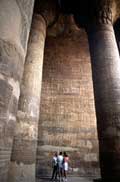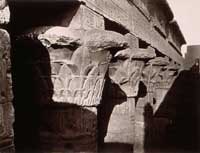|
Esna
 Esna is located about 33 miles south of Luxor. The town's Greek
name was Latopolis and here fish where thought to embody the
goddess Neith, who was sacred to the area. Esna is located about 33 miles south of Luxor. The town's Greek
name was Latopolis and here fish where thought to embody the
goddess Neith, who was sacred to the area.
Esna was increasingly important during the 18th dynasty due to
Egypt's developing relationship with the Sudan.
There was a route established between Esna and Derr.
Later, the city slowly declined until it received renewed
interest during the 26th Dynasty.
Later, under the Greeks and Romans, it became the capital of the
Third Nome of Upper Egypt.
There is also a barrage just outside of town which was built in
1906. About 4 miles southwest of town is the Deir Manaos Wa al-Shuhada
(Monastery of the Three Thousand Six Hundred Martyrs), who's
10th century church is said to be one of the most beautiful in
Upper Egypt.
 Perhaps
this monastery is a lasting commemorative to Emperor Decius
(249-51 AD) who degreed that all Christians would suffer death
if they did not sacrifice to the pagan gods. Perhaps
this monastery is a lasting commemorative to Emperor Decius
(249-51 AD) who degreed that all Christians would suffer death
if they did not sacrifice to the pagan gods.
His cartouche was the last to be carved on the walls of the
Temple of Khnum in Esna.
But the main attraction is the Temple of Khnum, which lies
beneath the level of the houses in a pit.
Near the Temple of Khnum on the stone quay along the corniche
are carved cartouches of Emperor Marcus Aurelius.
|